
Cynognathus is an extinct genus of large-bodied cynodontian therapsids that lived in the Middle Triassic. It is known from a single species, Cynognathus crateronotus. Cynognathus was a predator closely related to mammals and had a southern hemispheric distribution. Fossils have so far been recovered from South Africa, Argentina, Antarctica, and Namibia.
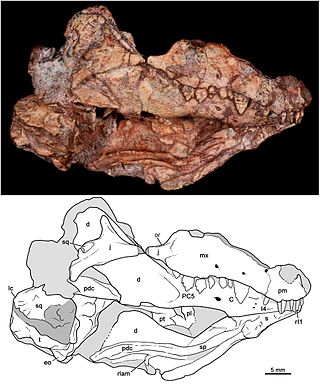
Probainognathidae is an extinct family of insectivorous cynodonts which lived in what is now South America during the Middle to Late Triassic. The family was established by Alfred Romer in 1973 and includes two genera, Probainognathus from the Chañares Formation of Argentina and Bonacynodon from the Dinodontosaurus Assemblage Zone of Brazil. Probainognathids were closely related to the clade Prozostrodontia, which includes mammals and their close relatives.

Probainognathus meaning “progressive jaw” is an extinct genus of cynodonts that lived around 235 to 221.5 million years ago, during the Late Triassic in what is now Argentina. Together with the genus Bonacynodon from Brazil, Probainognathus forms the family Probainognathidae. Probainognathus was a relatively small, carnivorous or insectivorous cynodont. Like all cynodonts, it was a relative of mammals, and it possessed several mammal-like features. Like some other cynodonts, Probainognathus had a double jaw joint, which not only included the quadrate and articular bones like in more basal synapsids, but also the squamosal and surangular bones. A joint between the dentary and squamosal bones, as seen in modern mammals, was however absent in Probainognathus.
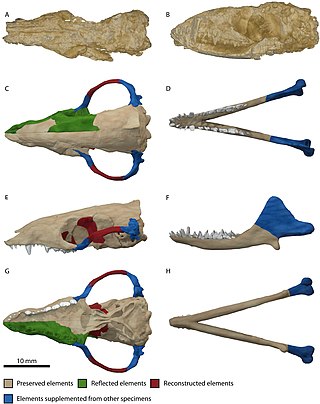
Morganucodon is an early mammaliaform genus that lived from the Late Triassic to the Middle Jurassic. It first appeared about 205 million years ago. Unlike many other early mammaliaforms, Morganucodon is well represented by abundant and well preserved material. Most of this comes from Glamorgan in Wales, but fossils have also been found in Yunnan Province in China and various parts of Europe and North America. Some closely related animals (Megazostrodon) are known from exquisite fossils from South Africa.

Megazostrodon is an extinct genus of basal mammaliaforms belonging to the order Morganucodonta. It is approximately 200 million years old. Two species are known: M. rudnerae from the Early Jurassic of Lesotho and South Africa, and M. chenali from the Late Triassic of France.

Abrictosaurus is a genus of heterodontosaurid dinosaur that lived during the Early Jurassic in what is now in parts of southern Africa such as Lesotho and South Africa. It was a bipedal herbivore or omnivore and was one of the most basal heterodontosaurids. It was approximately 1.2 metres (3.9 ft) long and weighed between 0.68 and 3 kilograms.
Zanclodon is an extinct genus of archosauriform from the Erfurt Formation in southern Germany. It was once a wastebasket taxon until a taxonomic revision by Schoch (2011) left only the paratype within Zanclodon laevis proper. The type species is Z. laevis.
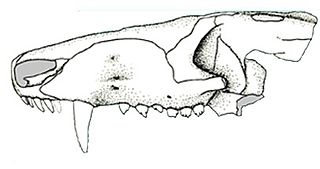
Prozostrodon is an extinct genus of probainognathian cynodonts that was closely related to mammals. The remains were found in Brazil and are dated to the Carnian age of the Late Triassic. The holotype has an estimated skull length of 6.7 centimetres (2.6 in), indicating that the whole animal may have been the size of a cat. The teeth were typical of advanced cynodonts, and the animal was probably a carnivore hunting reptiles and other small prey.
Tricuspes is an extinct genus of cynodonts that lived in what would be Europe during the Triassic from 203.6 to 199.6 mya, existing for approximately 4 million years. Three species are known: Tricuspes tubingensis, Tricuspes sigogneauae and Tricuspes tapeinodon, which are all from the Late Triassic (Rhaetian) period in continental Europe.

Kuehneotherium is an early mammaliaform genus, previously considered a holothere, that lived during the Late Triassic-Early Jurassic Epochs and is characterized by reversed-triangle pattern of molar cusps. Although many fossils have been found, the fossils are limited to teeth, dental fragments, and mandible fragments. The genus includes Kuehneotherium praecursoris and all related species. It was first named and described by Doris M. Kermack, K. A. Kermack, and Frances Mussett in November 1967. The family Kuehneotheriidae and the genus Kuehneotherium were created to house the single species Kuehneotherium praecursoris. Modeling based upon a comparison of the Kuehneotherium jaw with other mammaliaforms indicates it was about the size of a modern-day shrew between 4 and 5.5 g at adulthood.
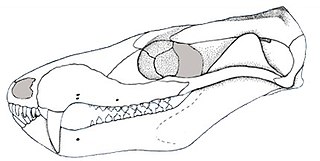
Brasilodon is an extinct genus of small, mammal-like cynodonts that lived in what is now Brazil during the Norian age of the Late Triassic epoch, about 225.42 million years ago. While no complete skeletons have been found, the length of Brasilodon has been estimated at 12 centimetres (4.7 in). Its dentition shows that it was most likely an insectivore. The genus is monotypic, containing only the species B. quadrangularis. Brasilodon belongs to the family Brasilodontidae, whose members were some of the closest relatives of mammals, the only cynodonts alive today. Two other brasilodontid genera, Brasilitherium and Minicynodon, are now considered to be junior synonyms of Brasilodon.

Progalesaurus is an extinct genus of galesaurid cynodont from the early Triassic. Progalesaurus is known from a single fossil of the species Progalesaurus lootsbergensis, found in the Lystrosaurus Assemblage Zone of the Balfour Formation. Close relatives of Progalesaurus, other galesaurids, include Galesaurus and Cynosaurus. Galesaurids appeared just before the Permian-Triassic extinction event, and disappeared from the fossil record in the Middle-Triassic.

Trirachodon is an extinct genus of cynodonts. Fossils have been found in the Cynognathus Assemblage Zone of the Beaufort Group in South Africa and the Omingonde Formation of Namibia, dating back to the Early and Middle Triassic.

Pachygenelus is an extinct genus of tritheledontid cynodonts. Fossils have been found from the Karoo basin in South Africa and date back to the Early Jurassic.

Ptychoceratodus is an extinct genus of lungfish living from Early Triassic to Middle Jurassic. It was established by Otto Jaekel for one species, transferred from Ceratodus genus. Type species is P. serratus from the Middle Triassic of Switzerland and Germany. Ptychoceratodus had two pairs of massive dental plates, bearing 4-6 acute ridges. Its skull roof was composed from massive, plate-like bones. In the central part of skull roof was localized an unossified fenestra. Most of the Ptychoceratodus findings are isolated dental plates, some associated with jaws. Other parts of skull or postcranial skeleton are relatively rarely found as fossils. The anatomy of skull is the best recognized in P. serratus, whereas less complete cranial material is available also for P. concinuus, P. phillipsi, and P. rectangulus. Although Ptychoceratodus is known exclusively from the Triassic and Jurassic, there were also Cretaceous specimens referred to this genus. However, they are more often regarded as representants of Metaceratodus. Ptychoceratodus is the only member of the family Ptychoceratodontidae. The first named species is P. phillipsi by Louis Agassiz in 1837 as a species of Ceratodus and later moved to Ptychoceratodus genus. Occurrences of Ptychoceratodus come mainly from Europe. However, occurrences from other continents suggest it was dispersed globally during the Triassic. After 2010, the new fossil material behind the Europe was reported from South America, India, and Greenland
Tikitherium is an extinct genus of mammaliaforms from India, known from a single upper tooth. Originally argued to be a primitive mammaliaform from the Late Triassic, a 2024 study argued that it actually represented the remains of a shrew from the Neogene. Tikitherium refers to Tiki, the village located near the Tiki Formation where the specimen was originally thought to have come from, and therium is Greek for “Beast”. The species was named copei in honor of Edward Drinker Cope for his pioneering discoveries towards understanding mammalian molars.

Lisowicia is an extinct genus of giant dicynodont synapsid that lived in what is now Poland during the late Norian or earliest Rhaetian age of the Late Triassic Period, about 210–205 million years ago. Lisowicia is the largest known dicynodont, as well as the largest non-mammalian synapsid, reaching about 4.5 metres (15 ft) long, standing up to 2.6 metres (8.5 ft) tall at the hips and weighing around 5–7 metric tons, comparable in size to modern elephants. It was also one of the last dicynodonts, living shortly before their extinction at the end of the Triassic period. Fossils of a giant dicynodont were known from Poland since 2008, but Lisowicia was not named and officially described as a new species until late 2018.
Delsatia is an early mammaliaform genus that lived during the Late Triassic and has been found in France. The type species, D. rhupotopi, was named in 1997. It was originally tentatively placed within the Docodonta, but subsequent studies disagree with this; Delsatia is seen by most as a basal mammaliaform. The holotype, MNHN.F.SNP408W, is an incomplete, isolated tooth.

Pachygonosaurus is a genus of ichthyosaur from Upper Silesia, Poland. It was described in 1916 by Friedrich von Huene and it has one single species, Pachygonosaurus robustus, based solely on the holotype, composed of two vertebral centra discovered in 1910, with a further three vertebrae also possibly belonging to the genus. Nowadays, Pachygonosaurus is considered a nomen dubium.
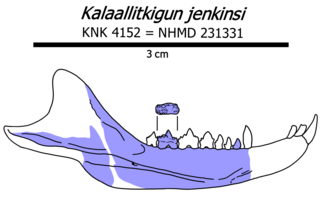
Kalaallitkigun is an extinct genus of haramiyidan mammaliaforms from the Late Triassic of Greenland. It contains a single species, Kalaallitkigun jenkinsi, which was described in 2020 from a partial dentary found in the Fleming Fjord Formation. More specifically, it was found in the mid-late Norian Carlsberg Fjord beds of the Ørsted Dal Member. It is the oldest of several mammaliaform species discovered in the Late Triassic sediments of Greenland. It is also the oldest mammaliaform with double-rooted teeth, and its pattern of tooth cusps help to clarify the evolution of haramiyidan teeth relative to their morganucodont-like ancestors.





















